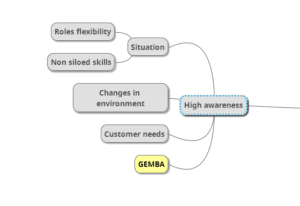Curiosity – Cornerstone of a Good Team
Curiosity – Cornerstone of a Good Team
Earlier in this blog I have presented the mind map shown below. I claimed that behind great teams, there are the following six elements: awareness, leadership, team spirit, sustainability, good results, and helping others. The best teams are not “one hit wonders”: month after month, year after year, they can reach amazing results while still avoiding putting too much strain on the team. Hard work alone can give you results for a certain period of time, but if the other elements are not in order, your success might remain short-lived.
This mind map has three straight lines called “curiosity to influence”, “fun to grow”, and “everyone is a leader”. In the following blog posts, I aim to explain these six elements and three lines.

The Most Important Thing?
I’m wondering which line I should explain first. Should I start from the well-being of the team or from continuous development and sustainability? Those who know me from my “previous life” might remember how important the well-being of the team and a nice office atmosphere were to me. To me, these were key factors on the road to success. But, in part, it might be that a great atmosphere is a result of success. So, perhaps it is not the most logical place to start. Development and sustainable work also require that you know your destination.
Would leadership (and its objective and vision) be a good place to start? Or perhaps the other end of that line, the continuous great results? Hmm. It could be, but there’s just one thing: agile teams do not usually have one strong leader. Gone are the days when knowledge workers were managed like armies. Great teams are not lead by a strong leader. In my model, management includes the objective, vision, self-management, and discipline. These are all very important elements, but they might not be the most essential ones.
No – the most important element of a good team is curiosity.
Winners Find New Solutions Instead of Treading the Same Paths as Others
Curiosity is about thinking if better solutions or technologies exist, if solutions could be achieved more simply, or if codes could be refactored to save time and to create new features more easily. It all begins from curiosity! If the team is not curious, it will continue to tread the same paths as before, not questioning the information that comes from outside. The team would not be genuinely interested in the client’s problems. Do you now see the importance of curiosity? Teams that remain curious will open up new avenues and experiment with new things. It is the culture of experimentation that forms the basis of agility.
No team can be perfect right from its first steps. Good teams are the result of development and learning. Even if you put a bunch of superstars in the same team, they would not play well together without practicing, without learning cooperation and the right moves. What is the basic requirement for efficient learning? You’re right: it is curiosity, just as is highlighted in this study. I doubt that humans could have developed or invented anything without curiosity. Without it, the only purpose of learning would be to avoid pain, not to find new solutions. Studies have even shown that curiosity increases the body’s dopamine levels, which then stimulates the brain in a similar way that certain drugs would.

Being Curious About the Client’s Needs
Great teams do not exist without good results. The basis of everything should be that the team knows what is expected from it. What do the clients need? What kind of problems do they have? How have they received the new features? How will the product or solution be used? Who will be using it? I pray for the team that is otherwise doing well but fails to be curious about the client. The right product – the right features. According to studies, this is the most important element behind great teams.
The team should aim to discover, in every way possible, what the result should be like. Creating the result is much easier than discovering its goal.
The Committee Will Tell You – NOT
Sometimes teams can trust an outsider, the product manager or some kind of a committee, to bring them a processed idea on what the team should do. I doubt that this would work in the long run. If the team assumes that others know better than they do, where will it take them? In a situation like that, you cannot question the information brought to you.
You should also view curiosity and awareness on a broader scale, outside the client’s needs. In what kind of a situation is the team or organization? What is happening in technology? Would it be possible for us to work more efficiently?
Being Curious About the Work of Others
A good team makes sure that information and competencies are evenly distributed among the team members. A good team can be flexible. For example, developers can assist in testing, and others can help the Product Owner in defining the stories. Siloed teams with very distinctly distributed roles and competencies cannot be great teams. While these teams can achieve good results, they are vulnerable to changes.
Being Curious About the Other Person
Great teams create an atmosphere where the team members can get to know each other. Team members should be able to have other discussion topics besides work and get to know each other outside the workplace. Different hobbies, values, beliefs, and ideas bring more energy to the team and the cooperation.
Next time, we will take a look at the other end of this line and discuss helping others. That, too, might be an unexpected choice for one of the most important elements of a good team.

Rush, Inflexible Processes, Bad Team Spirit – Several Factors Can Kill Curiosity
When you look at the environment your team or teams work in, pay attention to the situations, office arrangements, processes, and ceremonies that could encourage curiosity. Several factors can kill curiosity: continuously focusing on quick deliveries, constant interruptions, changing priorities and objectives, suppressed creativity, constant rush, lack of discussion and communication…
Good Agile Practices Enable Curiosity and Creative Solutions
While the purpose of agile practices is mainly to encourage curiosity and creativity, they cannot directly guarantee that the team is curious. Systematic Scrum and Kanban help the team to avoid feeling like they are in a hurry. I would still say that the team’s Scrum Master, and possibly even the Product Owner, have a central role in increasing the team’s curiosity. Curiosity comes from the individual team members, and the Scrum Master is often their closest coach. These examples and team coaching can help demonstrate the value of curiosity. Every one of us can make choices in our work: should we aim for results that are “good enough”, just like before, or should we aim to reach new, possibly better, results?
The Scrum Master and the Product Owner might suggest or even require people to find new solutions.
Coach the Coaches – Warning: Contains Product Placement!
How can the team coaching skills of Scrum Masters and Product Owners be improved? The solution is simple: let Contribyte help you. We have 12 years of experience in assisting not only agile teams but also the key team members, Scrum Masters and Product Owners, to contribute to the improvement of the team’s methods and team spirit. As a result, the team’s creativity and curiosity are brought to a new level. To prove this claim, we have helped more than 400 satisfied clients and thousands of teams.
At the moment, we are offering two new training solutions for Scrum Masters and Product Owners. For Scrum Masters, we offer a premium training called “World Class Scrum Master”, which goes far beyond what normal two-day certification trainings have to offer. The WCSM training gives you concrete tools, not just theoretical knowledge, on Agile: for example, an extensive team coaching toolkit. The WCSM training can be organized as a one-day module concentrating on a specific issue or as multiple modules set for a longer period. We have also had positive experiences with one-day trainings followed by one or two workshops held a few months after the training. Practice makes perfect, and the checkpoints ensure that the things learned in the training are put into practice.
For Product Owners, we are offering our new one-day training material “Successful Product Owner – 8 principles”. In this course, we introduce the basic role and routines of the Product Owner and discuss the factors behind successful Product Ownership to give the participants a better insight into the role of the Product Owner. This training also focuses on how the Product Owner should act to become successful.

If a team improves their performance by, for example, 5%, how much profit does that bring to your company?
Can you afford to leave your Product Owners, Scrum Masters, or teams without assistance and tools? Think about how much additional improvement and savings it could bring if the teams improved their performance by a small percentage. By updating the competences of the team and its key members, this would not only be possible but also quite easy. All it takes is contacting us!

Arto Kiiskinen
Senior Consultant
In his career, Arto has worked in product development as a Product Owner, Scrum Master and Product Development Manager. The operating methods of both large and small companies have become familiar. Arto loves to improve organizational learning and product owner know-how, and write blogs on different topics. Because retrospectives are one of Arto’s favorite topics, some of his customers have given him the nickname “Retroman”. During his free time, Arto tries to live healthy, buy as many cars as possible, rewatch the Star Gate series and study to become a Personal Trainer. Arto has also written the book “OWN IT – 8 Simple Secrets of Product Owner Success”.




